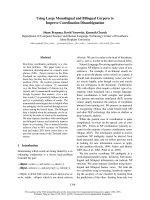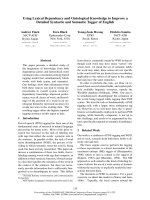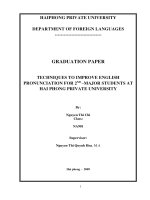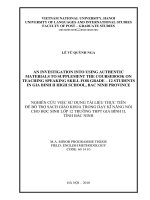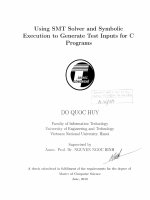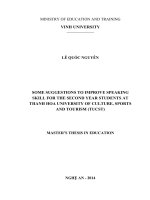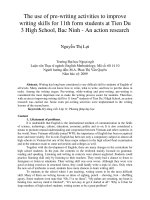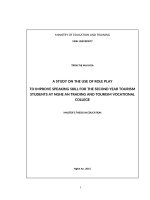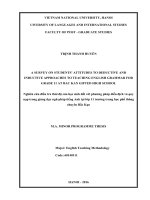Using useful experiences and reading exercises to improve reading skill for grade 10 students
Bạn đang xem bản rút gọn của tài liệu. Xem và tải ngay bản đầy đủ của tài liệu tại đây (131.45 KB, 22 trang )
TABLE OF CONTENTS
Contents
Pages
Part A. Introduction.
1.1.Rationale
2
1.2. Aims and objectives of the study
3
1.3. Methods of the study
3
1.4. The scope of the study
3
1.5. Design of the study
3-4
Part B. Development.
Chapter 1. Theoretical background
4-9
1.1.The ways to read English texts
4
1.2. Reading sub-skills
4
1.3. Principles of teaching reading
5
1.4. Steps for presenting a reading text
5
1.5. The two kinds of reading text
5-7
1.6. Techniques of teaching reading
8-9
Chapter 2. Some main kinds of reading exercises
9-16
Chapter 3. Application to teach a reading text
17-21
3.1 Games
17
3.2 A model lesson plan
18-21
Part C. Conclusion
21
References
PART A. INTRODUCTION
1
1.1.Rationale:
Since 2006 the new set of English textbooks has been used on the national
scale. The aim of the teaching and learning of English in secondary schools in
Vietnam is to enable students to use English as a means of communication at
basic level in listening, speaking, reading, and writing.
Teachers always try to find the best methods to teach their students. I do,
too. I have many experiences during my life of teaching, such as experiences in
teaching Listening, experiences in teaching speaking, experiences in teaching
reading and experiences in writing.
Being a teacher of English at a secondary school I am aware that teaching
and learning how to read is of great importance and bears a numerous challenges
to both teachers and learners
In this material, I will tell you my experiences in teaching reading, I myself
think the following are the best experiences of my own. But each person has
different points of view. Anyway, I hope my experiences will be supported and all
of you are certain to help me make my experiences better and better after reading
my experiences.
Reading skill is one of the most important skills to language learners. The
purposes of learning English are to learn how to listen, read and write well.
English is an international language. It is a means to communicate with other
people in the world. Moreover, many books are written in English. So how to
help the readers understand information written in English in books, newspapers
and magazines, etc is more important. If students have a good reading skill, they
can easily understand the information written in English well.
To English teachers, helping students drill their reading skill is more
important because it is one of the four skills in teaching English. Besides this,
teachers have to teach students reading skill so that they can understand the
knowledge in English books and in English tests.
To students, about 30 percent or even more than 30 percent of the exercises
in their English tests are to test their reading skill. Especially they are difficult for
the students. So if students have a good reading skill, they can easily complete
their English tests well.
Moreover, people said that “A good reader makes a good writer.” If
students are good at reading, of course, they are good at writing, speaking and
listening.
In conclusion, how to teach students to be good at reading skill in English
is very important. And my ideas are the reasons why I have spent most of my
time studying this topic: “Using useful experiences and reading exercises to
improve reading skill for grade 10 students”
1.2. Aims and objectives of the study
2
* Students get acquainted with many kinds of reading exercises, and they do
reading exercises well.
* Students have a lot of skills and methods in doing reading texts and their
reading skill is becoming better and better.
*Students read English texts more fluently and they can easily understand the
contents of the English texts.
*students can do many reading exercises in the reference books by themselves at
home.
*students enjoy reading periods.
*When my students take part in examinations, they all get good results at
reading.
* Students have a lot of abilities in doing reading exercises and they do reading
texts carefully.
*Students’ English pronunciation is better.
1.3. Method of the study.
First of all, I use the knowledge of methods I have learnt at University.
Secondly, I read many methodological books to get the knowledge of methods to
teach reading.
Moreover, I have learnt many experiences from my colleagues.
With all the knowledge I have collected, I use them in teaching my students
reading skills. After that, I choose the methods which are the most suitable for my
students, this means that I choose the methods which make my students good at
reading skill.
I use these methods many times and then they become my own
experiences, now I are writing my own experiences in teaching reading in this
material.
1.4 The scope of the study.
In the study, because of our limited time and knowledge, I only focus on
the following contents (The ways to read texts, Sub-skills in teaching reading,
principles of teaching reading, steps for presenting a reading text, some purposes
of reading texts and techniques of teaching in reading)
I also mention to some kinds of exercises in reading and games often used
in teaching reading.
1.5. Design of the study
The study consists of three parts
Part A. Introduction
Information about the rationale, aims and objectives, scope, methods and
design of the study are provided.
Part B. Development
This part includes 3 chapters.
Chapter1: Theoretical background.
I mention the ways to read texts, sub-skills in teaching reading, principles
of teaching reading, steps for presenting reading texts, some purposes of reading
texts and techniques of teaching in reading.
3
Chapter2. I would like to give some kinds of exercises in reading, which help
students to read the texts effectively.
Chapter3. This chapter is presented with “Games often used in teaching reading
and a model lesson plan”
Part C. Conclusion.
I conclude what I have mentioned in my study paper.
PART B. DEVELOPMENT
Chapter1. Theoretical background
In this chapter, I mention the solution to solve the contents in this topic
1.1. The ways to read English texts:
There are many ways to read English texts.
1.1.1 Reading aloud
The purpose of reading aloud is to communicate someone’s information written
to other people such as reading newspapers, news, letters, passages, messages,
etc….
In teaching foreign languages, reading aloud has fewer effects to the development
of students’ reading skill, but It mainly helps students practice pronunciation,
intonation, stress or reading skill, but It mainly helps students practice
pronunciation, intonation, stress or reading for announcing something.
1.1.2. Silent reading
When we want to read in order to understand something or to get information, we
often read silently. It means that we only look at the words and understand them
in our mind.
1.1.3. Intensive reading. Including two kinds of reading.
* Reading for details or research.
* Reading for analysis. ( in order to learn the language)
1.1.4. Extensive reading. Including three kinds
* Reading for pleasure
* Scanning
* Skimming.
1.2. Reading sub-skill.
There are some main reading sub-skills that I often drill my students.
1.2.1. Reading for recognizing words and their meanings in the text.
1.2.2. Reading for understand sentences or paragraphs in the text.
1.2.3. Scanning.
1.2.4. Skimming.
1.2.5. Predicting the content of the sentences or texts.
1.2.6. Guessing the meanings of the new words from contexts.
1.2.7. Using dictionaries for reading.
1.2.8. Inferring meaning.
1.2.9. Reading for total comprehension.
1.2.10. Critical reading.
1.2.11. Outlining.
1.2.12. Paraphrasing.
1.2.13. Summarizing.
4
1.2.14. Timed reading.
1.2.15. Strip stories.
1.2.16. Closing.
1.3. Principles of teaching reading
1.3.1. When teaching a reading text, It is beneficial to state a purpose for reading
a given text. Tell the students why they are reading the text. It is to skim for the
main ideas? It is to scan for specific information? It is for critical reading? The
purpose of reading task should be stated to the students to read by introducing the
topic of the passage.
1.3.2. Prepare the students to read by introducing the topic of passage.
1.3.3. Before the students read the text, have them read questions about it before
handing to help the focus on the meaning.
1.3.4. Do not pre-teach vocabulary unless necessary.
1.3.5 Have the students read silently without whispering the words or moving
their lips. This will help them read more quickly and focus on the more important
words.
1.3.6. Discuss difficult vocabulary after reading the text. If they do not
understand certain words by guessing from context, help them by explaining the
meaning, by definition or example.
1.3.7. When discussing the answer to comprehension questions, be sure to refer
back to the text often.
1.3.8. Finally, remember to focus on developing the skill of the readers. The
purpose of teaching reading is not only to help the students understand the
context for that day, but also to help them to read effectively for themselves. To
do this, they must develop many sub-skills of reading like skimming, scanning,
predicting, guessing from context and reading for total comprehension.
1.4: Steps for presenting a reading text
1.4.1. Give a brief introduction to get students thinking about the topic of the text.
1.4.2. Ask students to say more words they know about the topic.
1.4.3. Teach more key words.
1.4.4. State a purpose for reading the text (skim, scan, read for total information,
etc…)
1.4.5. Write one or two guiding questions on the board to focus their attention.
1.4.6. Tell the students how much time they have to read. Do not allow them
much time, especially in skimming and scanning exercises.
1.4.7. Have the students answer the given questions about the text.
1.4.8. Present a follow-up activity. In this, the students can share their own
opinions or discuss what else they know about the topic of the text.
1.5. The two kinds of reading text.
There are many purposes of reading texts, but in this material I will mention two
kinds of reading texts with two different purposes
*. The reading text in order to present the language
*. The reading text in order to teach students reading skills
How to exploit the two kinds of reading texts.
1.5.1.Eploiting the reading text in order to present the new language
5
If the main aim of the reading text is to present the new language, the
teacher’s work is to help students understand the text through presentation,
explanation, and noticing students about the contents as well as the new language
in the text. Then the follow- up tasks are in order to check the students’
understanding and the use of the new language.
Following are the basic steps to exploit the reading text in order to present the
new language:
- Introducing the text by using many different techniques such as telling stories,
asking questions, revising previous lessons relating to the new lesson.
-Introducing the content of the text (using picture if possible) and introducing
new words and structures. If the text is long, we can divide it into small
paragraphs.
- Practicing asking and answering about the text, using the new language in the
text.
- Practicing the new language in the content of the text and the content of the
text.
- Consolidating, summarizing, building up the text, using the following exercises
* Rearrange the text in order.
* Build up the text.
* Retell the story with prompts given.
* Retell each part orally.
*Sum up the main ideas of the text, basing on the prompt given.
- Read the text aloud in order to practice pronunciation, intonation.
- Follow –up activities (interpret the 4 skills; listening, speaking, reading and
writing.)
1.5.2. Exploiting the reading text in order to develop students’ reading skills.
In some reading texts in order to develop students’ reading skills,
teachers not only help students to understand the contents of the text, but also
give out some follow- up tasks in order to help students practice their reading
skills. Those skills can help students read different passages with different
purposes. In this kind of reading text, teachers do not present, introduce the
content of the reading text, but the students themselves have to read the text and
find out the content of the reading text. The role of the students is to help,
prompt, guide, give out suggestions, and check the students’ answers.
The activities in order to develop students’ reading skills are usually carried
on with 3 stages:
-Pre-reading activities.
-While-reading activities.
-Post-reading activities.
1.5.2.a. Pre-reading activities:
The activities and the techniques at this stage are in order to reach the
following purposes:
-Arouse interest (gây hứng thú)
- Set up the context (thiết lập ngữ cảnh)
- Create reason for reading.
6
- Pre-teach structures, new words.
- Introduce briefly the topic: content.
-Eliciting, guiding questions.
-Predict the text.
-Give expectation about the text. (nêu những điều muốn biết về bài đọc)
1.5.2. b. While- reading activities.
While-reading activities are exercises which are done while students are reading
the text. Students can read the text many time and do these exercises. At this
stage, students exploit the content of the text. Depending on the purpose and the
content of each certain text, there will be different questions and different
requirements.
The following are activities and techniques usually used at this stage:
-Find the word/sentence that says…………
-Check/tick the correct answer.
-True- false
-Complete the table
-Fill in the chart
-Make up charts/diagrams.
-Make a list of………………
-Matching
-What does………..stand for? / refer to?
-What does…………mean?
- Answer the questions on the text.
1.5.2. c. Post-reading activities.
After students read and do the exercises about the text, teacher go on giving
some exercises that require the understanding of students about the total content
of the text, relate to real life, consolidate the structures, and the new language in
the text.
Following are some kinds of exercises usually used at this stage:
-Arrange the events in order.
-Find the sentence that summarizes the paragraph / text.
-Give the title of the reading text
-Give comments, opinions on the characters in the text
-Discussion questions.
-Reproduce the text (written or oral)
-Gap-filling.
-Rewrite the story from jumble sentences/ words/visual cues.
-Role-play basing on the text
-Make dialogues basing on the text
-Guess the consequences/ result of the story.
-Develop another story basing on the text.
-Personalized tasks (eg: write /talk about your own school/ family/ town /story
on..)
*Tell a similar event on…
* What would you do/ behave/ say in that situation?
7
* Make your own plan/ decision…
-Grammar practice and exercises, etc……….
1.6. Techniques of teaching reading.
1.6.1. Pre- reading techniques.
1.6.1. a. Ordering statements.
-From a story, the teacher jumbles the sentences in the story and then asks the
students to put the sentences on the correct order.
1.6.1.b.Jigsaw dictation.
Ex: Draw a stadium and give some words about the players.
-Ask the students to put the words (the names of the players) in the right places in
the stadium to have a team in the field.
1.6.1.c. Ordering pictures.
Ex: When students read a text about a Christmas tree, the teacher gives some
pictures about ornaments, color light, gifts, etc…and a Christmas tree. Students
have to put the pictures in the right positions on the Christmas tree.
1.6.1. d Listen and draw.
Ex: When the students read a text about a farm The teacher reads a description
about the things on the farm, students listen and draw the scenery on the farm.
1.6.1. e True- false statement prediction.
Ex: when student read a text about a famous person, the teacher give some
information about that famous person such as : date of birth, place of birth, date
of death, famous inventions…. Students have to guess whether that information
is true or false.
1.6.1. f Open –prediction.
Ex: When students read a text about the Tet holiday, the teacher gives some
questions such as:
- What do Vietnamese children do at Tet?
- Do children in England visit their relative during the Tet holiday?
-What do people in Viet Nam prepare for Tet?
Students have to find out information to answer these questions.
1.6.2.While- reading an post-reading techniques.
1.6.2. a. True-false statements.
1.6.2. b. Yes- no questions
1.6.2.c. Right or wrong (v) or(x).
1.6.2.d.. Answers given: the teacher gives some answer and students have to
make questions for those answers.
1.6.2.e. Wh-questions:
1.6.2.f. Multiple choice: Choose the best answer A,B, C or D
1.6.2.g. Gap- filling:
1.6.2.h. Grids and forms
1. Name:
2 Place of birth
3.Date of birth
4. Job:
5.Place of burial:
8
6. Date of death
7.Name of his/ her novels:
1.6.2.i. Role-play
Interviewer
Shakespeare
Where were you born?
->I was born in……
When were you born?
10. Matching:
1.6.2.j. Rewrite:
1.6.2.k. Discussion:
1.6 2.l.. Songs and rhyms / songs on tapes.
Beside the techniques I often use above, the following are also techniques
which are used in teaching reading.
DIY word order; Tapped dictation: Write the text before you read it: Draw a text:
agreeing and disagreeing: Punctuating a text: First and Last Letter Dictation;
Chain story; Tape Dictation; Did you read that?; Question Brainstorming; Spider
Diagram; Dictated Titles; The Really New and the Merely New; Keywords;
Hiding words in the text; Visualizing the text.
Chapter 2. Some main kinds of reading exercises.
This chapter students must get acquainted with many kinds of exercises when
studying reading skills. The following are some of the most popular kinds of
reading exercises.
2.1. Read a text and decide whether the following statements are true or
false.
Ex: Read the passage and decide if the statements below are true(T) or false(F)
Pollution is a major problem of our times. Air, water and land are all polluted.
Poor waste disposal is to blame for many of the problem and the situation is
particularly acute in heavily industrialized and over- populated regions. Pollution
of the atmosphere has led to the destruction of the ozone layer and to the green
house effect. Other environmental problems have been caused by too rapid a use
of resources. There are far fewer fish in the sea because of over-fishing and the
destruction of the rain forests is having unforeseen ecological consequences.
Battery farming provides a lot of food but involves keeping animals in unnatural
and unhealthy condition.
*.Decide if it is true (T) or false (F). Correct the false sentences.
1…………Pollution is an important problem nowadays.
2………..Pollution of the atmosphere has destroyed the ozone layer.
3……….There are more fish in the sea due to over-fishing.
4………..Battery farming provides a lot of food and involve keeping animals in
good condition.
5………….Poor waste disposal causes pollution.
Answers: 1T, 2T, 5T
3F-> there are far fewer fish in the sea because of over –fishing.
4F-> Battery farming provides a lot of food but involves keeping animal in
unnatural and unhealthy condition.
9
2.2. Read an open –text and find out the suitable words to fill in the blanks.
(the words are not given, so students have to think and find out the suitable
words to fill in the blanks).
Ex. Read the open text and then find the missing words to fill in the blanks.
Everyone wants to reduce pollution. But pollution problem is (1)……
complicated as it is serious. It is complicated (2)………..much pollution is
caused by things that benefit people. For example, exhaust(3)
………..Automobiles causes a large percentage of all air pollution. But
automobiles (4)………….transportation for millions of people. Factories
discharge much of the material (5)…….Pollutes the air and water, but factories
give employment to a large (6)……..of people. Too much fertilizer or pesticide
can ruin soil, but fertilizers and pesticide (7)………..important aids to the
growing of crops. Thus, to end (8)…….greatly reduces pollution immediately,
people would have to (9)………….using many things that benefit them. Most
people do not want to do that, of course. But pollution can (10)
………….gradually reduced in several ways.
Answers:
1 2
3
4
5
6
7
8
9
10
As Because/as from Provide which member Are
Or stop be
2.3. Read a text and answer the questions.
Ex: Read the text carefully, then answer the questions.
The ancient town of Hoi An lies on the Thu Bon River, 30 km south of Da
Nang. It was formerly a major trading center in Southeast Asian between the 16 th
and 17th centuries. Hoi An is famous for its old temples, pagodas, small tileroofed houses and narrow streets. All the houses were made of wood and their
pillars were carved with ornamental designs.
All visitors to Hoi An are recommended a visit to the Assembly Hall of
Cantonese Chinese Congregation. This house was built in 1855 and still keeps
many precious objects that belonged to the Chinese community of Hoi An.
Another attractive address to tourists is tan Ky House, which was constructed
nearly two centuries ago as a house of a Vietnamese merchant, the house now
looks almost exactly as it did in the early 19th century.
In recent years, Hoi An has become a popular tourist destination in Vietnam. In
1999, it was certified by UNESCO as a Cultural Heritage Site.
1.Where is the ancient town of Hoi An situated?
2.What was Hoi An Known as between the 16th and 17th centuries?
3.What is it famous for?
4. What are the house in Hoi An like?
5.How old is The Assembly Hall of Contonese Chinese congregation?
6. When was Tan Ky House built?
7.When was Hoi An declared by UNESCO as a Cultural Heritage Site?
*Answers: 1. The ancient town of Hoi An is situated on the Thu Bon River,
30km south of Da Nang.
2. Between the 16th and 17th centuries, Hoi An was known as major trading center
in southeast Asian.
10
3. Hoi An is famous for its old temples, pagodas, small tile- roofed houses and
narrow streets.
4. All the old houses in Hoi An were made of wood and their pillars were carved
with ornamental designs.
5. The Assembly Hall of Cantonese Chinese Congregation was built in 1855. It’s
about 152 years old.
6. The Tan ky House was built in the early 19th century.
7. In 1999.
2.4. Read a text and complete the summary, using the information from the
text.
Ex: Read the passage and use information from the passage to complete the
summary.
Minh, a student from Ho Chi Minh City, is an exchange student in the USA. He
is now living with the Parker family 100 kilometers outside Columbus, Ohio. He
will stay there till beginning of October.
Mr Parker grows maize on his farm, while Mrs Parker works part- time at a
grocery store in a nearby town. They have two children. Peter is the same age as
Minh, Sam is still in the primary school.
Since Minh arrived, he has been learning a lot about life on a farm. In the
afternoon, as soon as he completes his homework, he feeds the chicken and
collects their eggs. On the weekends, if Mr Parker is busy, the three boys help
him on the farm.
On Saturday afternoon, Peter plays baseball. The Parker family and Minh eat
hamburgers or hot dogs while they watch Peter play. The Parkers are nice so
Minh feels like a member of their family.
*Complete the following summary.
A Vietnamese boy named Minh is living with the Parker family in the American
state of (1)……….. . Mr Paker is a (2)…………and Mrs Parker (3)………..in a
nearby town. They have two children, (4)………..and (5)…………….Minh often
does chores (6)………..School. Sometimes, he also helps on the (7)…………
The family relaxes on Saturday afternoon and (8)……….Peter plays (9)………
Minh likes the Parkers, and she enjoys being a (10)……………of their family.
2.5. Read a text and fill in the incomplete sentences given with the
information from the text.
Ex; Read the passage carefully and complete the following sentences.
Northern Japan has been rocked by series of earthquakes and aftershocks that
began on 23rd October 2004 and left at least 23 people dead and thousands more
injured and homeless.
The initial quake that struck the Niigata prefecture on Honshu Island
measured 6.5 on the Richter Scale, with a depth of 9.8 miles, according to the
U.S. Geological Survey (USGS). The earthquake’s epicenter was located about
162 miles northwest of Tokyo in Ojiya City, where several deaths were reported,
housing was destroyed and landslides added to the devastation. Tremors from the
initial quake were said to have been felt as far away as Tokyo, with two
11
aftershocks measuring 6.2 and 6.0 on the Richter Scale and another 5.7magnitude earthquake occurred on Monday, October 25.
The quakes demolished more than 1,000 buildings, caused widespread power
and gas outages and damaged water mains. Rescue efforts were hindered by
impassible roads, lack of electricity and collapsed bridges.
a. A series of earthquakes and aftershocks happened in………in October, 2004.
b. The strength of the initial earthquake measured………………….
c. The strength and depth of the earthquake were measured by………………
d. The center of the earthquake was……………………………….
e. Tremors from the initial earthquake were felt in…………………, with two
aftershocks and another earthquake measuring…………….on the Richter Scale.
f. More than 1,000 buildings were………………………………………
g. After the earthquake, the supply of………….and………..was interrupted in
many places.
h. Impassable road, lack of electricity, and collapsed bridges prevented……….
2.6. Read a passage and then take role- play about the content of the text.
Ex: Read the passage about Isaac Newton and the take role- plays in pair: one of
you is an interviewer, the other is Isaac Newton.
Isaac Newton is one of the greatest men in the history of scientists. He was
born in a small village of wootsphore in England. His father was a poor farmer.
When the boy was fourteen, his father died. Newton left school and helped his
mother on the farm. But the boy did not like farming. He was fond of poetry and
mathematics. So Newton was sent to school where he studied well and made his
first scientific experiments. After he left school. Newton studied at Cambridge
University.
After graduating, Newton lectured on Mathematics at Cambridge University.
His greatest discovery is the law of gravitation.
He died on March 20, 1727. Today there is a monument of Newton in Trinity
College at Cambridge,
Interviewer
1.Where were you born?
2. What is your job?
3. What is your father job?
4.How old were you when your father
died?
5.
6.
7.
8.
Isaac Newton
->1.I was born in a small village of…
->2.I’m a scientist.
->3.He is a farmer
->4. When I was fourteen years old
2.7. Read a text and make questions for the answers given.
Ex: Read the passage and then use the information given to make questions.
VAN CAO (1923-1995)
12
Van Cao, a famous Vietnamese musician , was born on 19 th November, 1923 in
a poor worker family in Nam Dinh, Viet Nam. He started composing music when
he was very young. His first song was written in 1939 and he quickly became
famous. In 1944 he wrote Tien Quan Ca and it was chosen to become the
Vietnam National Anthem. Van Cao’s artistic works include songs, poems and
paintings. Van Cao died on 10, July, 1995 in HaNoi. Van Cao is known as a very
talented musician and highly appreciated by the Vietnamese people.
Answers given
Questions
1. A Vietnamese musician
->1 What was Van Cao’s job
2. In Nam Dinh, Viet Nam
->2. Where was he born?
3. In 1939
3
4. Tien Quan Ca
4
5. In 1995
5
2.8. Read a text and use the cues given to make questions and answer them.
Ex: Read the following passage, then make up questions and answer them.
Every day on radio, on TV, and in the newspapers, we hear, see, or read about
many problems in the world, for example, pollution problems.
Air pollution is the first kind. It mostly comes from fumes released from
motorbikes, cars, airplanes, trains, and poisonous gases emitted from factories.
Also, waste is dumped anywhere, even in the city where many people are living.
The second pollution problem is sea pollution. Many people earn their living
from fishing in the sea, and the fish they catch feed many people. But the sea has
become so polluted from oil spills and factory wastes that the fish are dying. This
pollution is not only killing the fish, but is also affecting those people who eat
fish.
Seldom do you find a place nowadays that is not polluted. This problem is
growing more difficult everyday. We must find a good solution that makes the
world a better place to live.
a. How often/ hear, see or read/ problem/ world?
b. What/ cause/air pollution?
c. Where/ rubbish/ dump?
d. What/ cause/ sea pollution?
e. What /happen /when/ sea/pollute?
f. What/ should/ do now?
2.9. Read the sentences. They belong to two passages, but they are mixed.
Sort the sentences out and put them in the correct order of each passage.
Ex: The following sentences belong to two passages, but they are mixed. The
passage A is about How the May Day holiday began in England. The passage
B is about Easter. Sort the sentences out and put them in the correct order of each
passage.
a. Many hundred years ago, there were many villages and few towns in England.
b. The villages liked to go into the forests and the fields when spring came.
c. Easter is a joyful festival which is celebrated in many countries.
13
d. On the first Sunday of may they usually took a tree back with them and put it
in the centre of the village.
e. It happens at around the same time as Passover.
f. The children danced round it and the men and the women took part in games
around it.
g. Later the international working class made the first of May their day of
solidarity.
h. On Easter Day, young children receive chocolate or sugar eggs as long as they
are good.
i. In many countries, people crowd the streets to watch colorful parades.
Answer:
Passage A
a-b-d-f-g
Passage B
c-e-h-i
2.10. Read an open-text and choose the correct word or phrase (A,B,C or D)
to complete the passage.
EX: Read the passage below and choose the correct word for each space.
Wale has a(0)………..of about three million. English is the main language and
only twelve percent speak both Welsh and English. Every year (1)……..August
there is a Welsh-speaking festival. It(2)………place in a different town each year
so everyone has the chance for it to be near them. Local people(3)………years
making plans for when the festival will be in(4)……….town. Each festival is (5)
………by about 160,000 people. They travel not only from nearby town and
villages(6)…………..also from the rest of the British Isles and (7)………from
abroad. There are concerts, plays and (8)………To find best singers, poets,
writers, and so on. Shops sell Welsh music, book, pictures and clothes as(9)
………as food and drink. The festival provides a chance for Welsh- speaking to
be together for a whole week with(10)……………Welsh language all round
them.
0. A. people
B. public
C. population
D. country
1. A. on
B. by
C. in
D. makes
2. A. takes
B. finds
C. has
D. makes
3. A. pass
B. put
C. spend
D. do
4. A. our
B. their
C. his
D. its
5. A. arrived
B. attended
C. joined
D. come
6. A. but
B. and
C. since
D. however
7. A. just
B. hardly
C. quite
D. even
8. A. test
B. examination C. competitions
D. races
9. A. long
B. far
C. good
D. well
10. A. one
B. a
C. the
D. some
Answer:
0
1
2
3
4
5
6
7
8
9
10
C
C
A
C
B
B
A
D
C
D
C
2.11. Read a text and fill in the form/ the grid.
Ex: Read the passage about Shakespeare and then complete the form.
14
SHAKESPEARE
Shakespeare, the famous English playwright, was born at Stratford-on –Avon
in central England in 1564. He married Anne Hathaway when he was eighteen
and had three children. After that he left his family and went to London to begin
his career as an actor, and later, a playwright. He wrote about thirty seven plays
of all kinds: comedies, tragedies and histories. Shakespeare is known all over the
world as the greatest name in English literature. He died in 1616 and buried in his
hometown.
1.Name:
6. Number of his children:
2. Date of birth:
7. Date of dead
3. Place of birth:
8. Place of burial
4. Job:
9. Names of his novels
5. His wife’s name
2.12. Read the mixed sentences and then rearrange them into the correct
order to make a complete passage.
Ex: The following sentences belong to a passage about Peter’s life, but they are
mixed. Put the sentences in their correct to make a complete passage.
a. He spent four years at the University.
b. After finishing University, he started working in s factory.
c. Peter finished school in 1980.
d. He became the director of the factory in 1994.
f. He went to University at the same year.
e. In the year 2000 he came back to England.
g. In 1996 he came back to Viet Nam to do the business.
h. In 1984 he finished University.
*Answer:
c-f-a-h-b-d-g-e
2.13. Read an open- text and choose the words given to fill in the blanks.
late, lunar, greeting, celebrated, make, on, sticky, their, visits, one
Vietnamese’s New year is (1)………..according to the Lunar calendar. It is
officially known as the(2)……..New year or Tet. It occurs in (3)…….January or
early February. The exact date changes from year to year. Vietnamese people
usually (4)………..preparation Tet holiday several weeks beforehand. They clean
and decorate(5)…………..homes cooks special food such as (6)………….rice
cakes, and make offerings (7)…………the family altars . On Tet, people usually
put on their new clothes ,give (8)…………..another the Tet season’s(9)………
and pay mutual(10)………
Answers:
1
2
3
4
5
6
7
8
9
10
Celebrated lunar Late make their sticky on one Greetings Visits
2.14. Read the text carefully and choose the correct answer.
The research of alternative resources of energy has resulted in different
directions. Many communities are burning garbage and other biological waste
products to produce electricity. Experimental work is being done to make
15
synthetic fuels from coal, or coal tars. But to date, that process has prove
expensive. Some experts are trying to revive hydroelectric power which is
derived. Fifty years ago, hydroelectric power provided one third of the electricity
used in the United States, but today it supplies only four percent. The oceans are
another source of energy. Scientist are studying ways to change the energy of
ocean currents. tides, and waves into electricity.
- Synthetic fuel: nhien lieu tong hop.
- hydroelectric power: nang luong thuy dien.
1. What are many communities doing to produce electricity?
a. burning garbage and other biological waste products.
b. changing waste products into power
c. searching for alternative resources.
2. Has the process of making synthetic fuels proved cheap or expensive?
a. It has prove cheap
b. It has prove expensive
c. It hasn’t prove expensive
3. Where is hydroelectric power derived from?
a. river and oceans.
b. lakes and streams
c. rivers and streams
4. What percentage of electricity used in the United States does hydroelectric
power provide today?
a. 33%
b. 35%
C. 4%
5. What are scientists studying?
a. ways to have electricity from the energy of ocean.
b. ways to change the energy of ocean currents, tides and waves into electricity.
c. a and b are correct.
Answer: 1-a, 2-b, 3-c,4 –c,5- c
2.15. Read a passage and number the sentences given as mentioned in the
passage.
EX: Read the passage, then number the sentences.
The students of Quang Trung School had a medical cheek –up yesterday. Hoa,
Lan and Nga filled in their medical records and gave them to the nurse. When the
nurse called her name. Hoa left in the waiting room and come to the nurse’s
room. First, the nurse took her temperature. Then, she measured her. Next, the
nurse weighed Hoa. Finally, the nurse told Hoa go to back to the waiting room.
Hoa went back to the waiting room to wait for the doctor.
a.The nurse weighed Hoa.
b.Hoa returned to the waiting room.
c.Hoa left the waiting room
d. The nurse called Hoa’s name
e. The nurse measured Hoa.
f. Hoa filled in her medical record.
g. The nurse took Hoa’s temperature.
h. The nurse told Hoa to go back to the waiting room.
16
Answer;
1
2
F
D
3
4
5
6
7
C
G
E
A
H
Chapter 3 Application to teach the reading skill.
8
B
3.1. Games.
Games are highly and motivating and competitive because they are amusing
and interesting. They can be used to give practice in all language skills, especially
in reading skill and be used to practice many types of communication.
Therefore, I present some games used in teaching reading.
3.1.1 Slap the board.
We can use the game in many ways such as;
-When students study words relating to objects such as fruits, vegetables, food,
drinks, things in a house, etc, the teacher can collects real things and hang them
on the board. Then the teacher reads the words in English, the students hear the
words and run to the board to slap the right objects.
-The teacher can read the words in English, the students hear the words and run
to the board and slap their Vietnamese meanings.
-The teacher can read the Vietnamese meanings, the students hear the words and
run to the board and slap the English words.
3.1.2. What and where.
- We can use this game to check students’ understanding of the new words. It is
better to use this game if there are a few new words in the lesson.
3.1.3. Rub out and remember.
We can use this game if there are a few words in the lesson and the new words
are not difficult to remember.
3.1.4.pyramid ( Ask the students work in groups to make a list of the words
relating to a topic) We can use this game at the Lead –in stage in order to help
students to remember as much as possible words relating to the topic of the
lesson.
z3.1.5. Matching.
- If there are many new words in the lesson, it is good for us to use this game.
There are many ways to do the matching such as;
Match the English words with their Vietnamese meanings.
Match the English words with the pictures.
Match the English words with real objects.
3.1.6. Lucky numbers.
-We can use this game at the warm-up stage in order to review the previous
knowledge.
-We can also use this game at the consolidation stage in order to check the
students’ understanding of the lesson.
3.1.7. Noughts and crosses.
This game can be used at the lead- in stage or at the consolidation stage.
3.1.8.Network.
We can use this game in order to help students remember words relating to the
topic of the lesson. This game is often at the lead- in stage.
17
3.1.9. Brainstorming.
-We can use this game in order to review the previous knowledge which relating
to the new lesson.
3.2
A MODEL LESSON PLAN
Reading lesson plan
UNIT 10. CONSERVATION.
A.READING
-Period 64Aims: By the end of the lesson, Ss will be able to:
-use vocabulary items related to the issue of conservation
-guess the meaning of words based on contexts and components of the words.
-Scan for specific information about conservation
-skim for general ideas about conservation
Materials:
-Tieng Anh 10: page
- Pictures
- Handout.
Method: Communicative approach, integrated skills.
Anticipated problems:
Ss may not know much about conservation, so T should be ready to give
explanation.
1.WARM-UP – To introduce the topic ( 5m)
Guessing game
-T prepares a piece of paper with the word “conservation”
-T asks on student to go to the board and gives him/her the paper.
- T asks other students to ask the student yes/ no questions to guess what the
word is. T can model some questions. The questions can be:
+ Is the word a verb?
+ Is it a noun?
+ Does it begin with “c”?
-Ss take turns to ask questions. The winner is the one who can guess the word
correctly in the shortest period of time.
2. BEFORE YOU READ. (8m)
Discussing the questions based on the pictures.
-T uses the pictures on page 104 to introduce the topic of the lesson to Ss
-The T asks Ss to work in groups of 5 to discuss the questions in the textbook.
-T goes round to provide help to Ss
-T asks some Ss to present their group’s answers and others to add any other
ideas.
Pre-teaching vocabulary.
(T should only teach the words which do not appear in Task 1)
-T elicits or teaches some vocabulary items;
(destroy, destruction, constant, conserve, clean up, worsen, pass law, play an
important part in sth. )
Using pictures to teach vocabulary.
-Ss guess the meaning of the new words.
18
-T feedbacks
-T reads the new words, Ss repeat.
WHILE YOU READ;
Setting the scene
You are going to read a passage about conservation. While you are reading, do
the tasks in the textbook.
Task 1 (7m) Matching based on word guessing
Instruction: You are required to match the word in column A with a suitable
definition in column B.
-T writes the words on the board. (Eliminate, circulation, run off, hydroelectric)
-T instructs Ss to read the passage quickly and stop at the lines that contain these
words to guess their meanings.
-Ss guess the meaning of the words based on the contexts in the sentences and the
components of the words. For example; to guess the meaning of (eliminate) Ss
read the sentence 2 in paragraph A. Then based on this sentence and other words
in the first sentence (lost, destroying) Ss can guess the meaning of this word.
Also, T can help Ss analyze the formation of the word: hydroelectric= hydro
(water, liquid) + electric.
-T checks that Ss understand the words correctly. T can check Ss’ understand by
asking them to provide the Vietnamese equivalents to the words.
-T instructs Ss to use some strategies to do task 1:
+ First, Ss should read through the definition provided in column B to
Understand these definition. Then Ss match each word with the suitable
definition.
-T asks Ss to work individually to do the matching.
-T goes around help Ss when necessary, and then asks Ss exchange their answers
with other Ss.
-T gives the correct answers (1.c, 2.a, 3.d, 4.b )
TASK 2(7m) True or False
Instruction: You are to read the passage and decide whether the statements are
true(T) or false(F).
-T instructs Ss to use some strategies to do the task:
+ First, quickly read through the statements to get an idea about the topic.
+ Read the first statement more carefully. Underline the key words to understand
the main point.
+ Search for the section of the text which deals with the idea or fact.
+ Once finding the relevant section, read it carefully. If the statement is similar to
the information in the text, then select “True’ If the statement is the opposite to
the information in the text, then select “ False”.
+ Continue with the rest of the statements.
-T asks Ss to work individually to do the task.
-T asks Ss to discuss their answers with their peers.
- T calls on some Ss to give their answers and asks them to explain their choices.
- T gives the correct answers.
1. True (line 2) 2. True (lines 3-5) 3. True (lines 11-12) 4. True (15-16).
19
5. False. (Without plants, most water would run off as soon as it falls. Rapid run
off would cause floods) (lines 11-12).
6. False. (We can stop worsening the problems) (lines 20-21).
TASK 3 Choose the main idea for each paragraph.(6m)
Instruction; You are to read the passage again choose the most suitable main
idea for each paragraph.
T instructs Ss to use some strategies to do the task:
+ Read the first paragraph carefully and try to sum up, in the Ss’own words, what
it is about.
+ Then search through the list of main ideas provided in the task to find the most
suitable answer.
+ Make sure the main idea chosen sums up the entire paragraph and not just one
idea within it.
+ Continue with the rest of the paragraphs.
-T goes Ss to work in pairs to do the task.
-T goes around to offer help when necessary.
- T asks Ss to exchange their answers with other pairs.
-T calls on some Ss to give their answers asks other Ss to say whether they agree
or disagree.
-T gives feedback and the correct answers; A. 3
B. 4
C.2
4. AFTER YOU READ.
Instruction; You are required to work in groups to discuss the questions in the
textbook.
-T divides Ss into 6 groups; 1,2,3,4,5 and 6
-T asks group 1 and 2 to discuss question 1, group 3 and 4 question 2, and group
5 and 6 question 3.
-T goes around to help the groups when necessary.
-When all groups have finished, T asks every two groups to share ideas with each
other.ack.
-T calls on some groups to report their ideas to the class.
-T gives feedback.
5. WRAPPING UP.
-T summaries the main points.
-T asks Ss to learn by heart all of the new words and do the extra exercise as
homework.
2. The results of the lesson plan
The lesson plan is applied with class 10B5. Students understood the contents of
the topic about the Conservation and the students are easy to understand the
lessons.
20
Class
Number of students
10B5
44
Number of students understand the lesson
40
Number of students misunderstand the lesson 4
As can be seen from the table with the help of teacher’s discourse competence,
teacher can provide a better lesson for his students and as a result, forming
discourse competence in his students. If teacher does not prepare more materials
using only sources available in the text book, his or her students are not given
adequate instruction on how to read the passage effectively.
PART C. CONCLUSION
In conclusion, to teach reading well, teachers of English must follow the
methods, the techniques, the principles, the steps, the games and the ways as
mentioned above. Moreover If the teachers want students to be good at reading
skill, they must provide many kinds of exercises to their students. Students must
practice these kinds of exercises frequently.
If teachers of English use the knowledge I mentioned in this material, I’m sure
that their classes are very exciting and their students are easily to understand the
lessons.
I think the knowledge I have mentioned in this material is very useful in
teaching reading. It is used widely in my school and we get best results in
teaching English.
To use the methods, the techniques, the principle, the steps, the games and the
ways I have mentioned in this material well, English teachers must prepare the
lesson carefully before the classes. The teachers must prepare the lesson plans
well. A good teacher must always read reference books to develop their
knowledge. The teachers must turn use different methods, different techniques in
different kinds of lessons so that their teaching has good results.
I hope that this study will benefit teachers and learns in teaching and
learning reading skill. However, this study may include some mistakes and
limitation. This is unavoidable because of the limitation of my knowledge, time
and materials for my study.
XÁC NHẬN CỦA THỦ TRƯỞNG Thanh Hoá, ngày 28 tháng 5 năm 2017
ĐƠN VI
Tôi xin cam đoan đây là sang kiến kinh
nghiệm của mình viết, không sao chép
của người khác.
( Tác giả ký và ghi rõ họ tên)
Đỗ Thị Tâm
21
REFERENCES
1.Tiếng Anh 10, Hoàng Văn Vân, Hoàng Thị Xuân Hoa, Đỗ Tuấn Minh,
Nguyễn Thu Phương, Nguyễn Quốc Tuấn, Nhà Xuất bản Giáo Dục, 2008
2. Tiếng Anh 10, Sách giáo viên , Hoàng Văn Vân, Hoàng Thị Xuân Hoa, Đỗ
Tuấn Minh, Nguyễn Thu Phương, Nguyễn Quốc Tuấn, Nhà xuất bản Giáo Dục,
2008
3. Thiết Kế bài Giảng: Nguyễn Thuỷ Minh, Lương Quỳnh Trang.
4. Teach English ( A training course for teachers) Trainer’s Hand book , Adian
Doff ( Cambridge University Press)
5.Cook, G (1989) Discourse, Oxford University Press.
22

